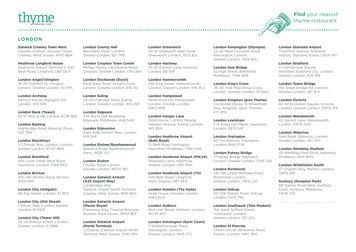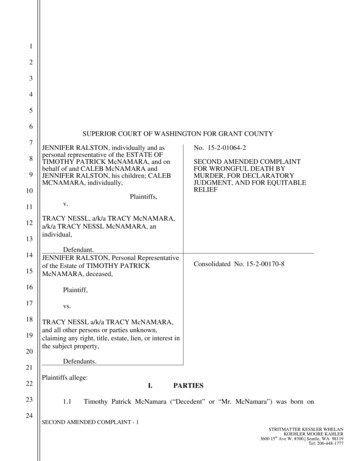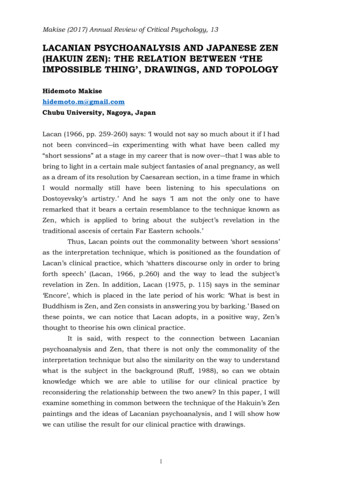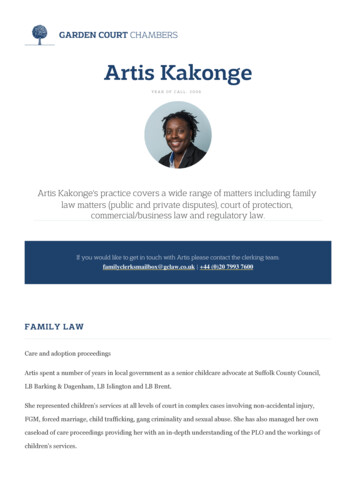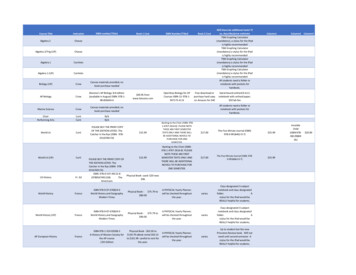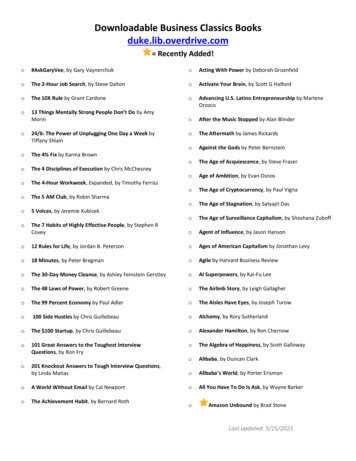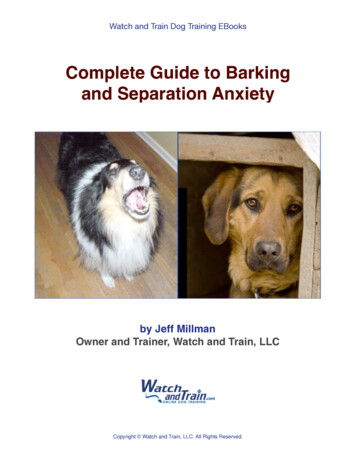
Transcription
Watch and Train Dog Training EBooksComplete Guide to Barkingand Separation Anxietyby Jeff MillmanOwner and Trainer, Watch and Train, LLCCopyright Watch and Train, LLC. All Rights Reserved.
Watch and Train Dog Training EBooksComplete Guide to Barking and Separation AnxietyTable of ContentsIf you are reading this on your computer, select any of the sectionsbelow to quickly go to that section.Complete Guide to Barking and SeparationAnxietyGet the Most Out of Your Purchase !4Introduction! 5General Training Strategies! 7Positive Reinforcement! 7Clicker Training!7Reasons for Using the Clicker or “Yes!”! 7Manage Your Dog When You Are Not Training! 8Identify the Cause of Barking!9Sound Reactivity!9Barrier Frustration! 9Barking at Other Dogs or People!9Demand or Attention-Seeking Behaviors! 9Separation Anxiety! 9Barking Treatment!11Change the Behavior Pattern! 11Sound Desensitization! 11Teach Your Dog to Be Quiet Around Noises !Specific Examples of Sound Desensitization!Desensitization to the Vacuum Cleaner! 17Barrier Frustration! 21Barking at Dogs or People on the Street! 26Copyright Watch and Train, LLC. All Rights Reserved.Table of Contents - Click Here1213Page 2 of 16
Watch and Train Dog Training EBooksComplete Guide to Barking and Separation AnxietyDemand Behaviors - Barking for Attention andTreats!29Teach “Quiet” to Stop Barking! 33Separation Anxiety - Anxiety When Alone!38Can Getting Another Dog Cure Separation Anxiety?!56Medication and Other Options for Barking and SeparationAnxiety !57Bark Collars and Other Non-Barking Tools For All Typesof Barking!59Barking and Separation Anxiety Troubleshooting Tips! 61Barking Prevention!64Separation Anxiety Prevention!Summary!6566Resources ! 68Copyright Watch and Train, LLC. All Rights Reserved.Table of Contents - Click HerePage 3 of 16
Watch and Train Dog Training EBooksComplete Guide to Barking and Separation AnxietyComplete Guide to Barking and SeparationAnxietyChapter 1Get the Most Out of Your PurchaseCongratulations on your purchase of the Stop Barking E-Book. Hereare some quick tips to read before you get started.1. While all my books are written for male or female dogs. I use thegeneral “he” or “him” in my writings. It is less cumbersome thanwriting “he or she” or “him or her” throughout the book.2. While you can feel free to print out the book, I encourage you toread the E-Book directly on your computer. Besides saving paper,you can also take advantage of internal and external links. Aninternal link will take you within the book and as long as you areconnected to the Internet, an external link will take you to awebsite to provide more information.3. To communicate with your dog, I recommend using a clicker orsaying the word, “yes”. Whenever I mention “click and treat” or(C/T), if you are not using a clicker you can say, “yes” instead. Ifyou don’t have a clicker, you can purchase them here.4. There is a lot of information in all my EBooks, but I don’t want youto feel overwhelmed. All of the exercises are broken down into stepby-step instructions to make it easier for you. Be patient and workin short sessions with your dog and focus on giving clear, consistentinstructions to him. It will get easier over time.Copyright Watch and Train, LLC. All Rights Reserved.Table of Contents - Click HerePage 4 of 16
Watch and Train Dog Training EBooksComplete Guide to Barking and Separation AnxietyChapter 2IntroductionBarking and separation anxiety are often intertwined dog behaviors.Sometimes a barking dog has separation anxiety. Dogs can bark forother reasons as well. This confusion and patience required fortreatment can make barking and separation anxiety two of the mostchallenging and troubling dog behaviors. They are also two of the topreasons that dogs get dropped off at shelters or guardians getcomplaints from neighbors and sometimes get fined from the city theylive in.Barking is one way that our wonderful dogs communicate to eachother and to us. No one knows for certain what capabilities dogs haveto communicate and how complex their language is. However, it isagreed that dogs use barking to alert to danger, to communicate theirneed for food or bathroom breaks and when they are scared.Some forms of barking can be amplified unintentionally by people. Ifyou let a barking dog out of his crate when he is barking, he willquickly learn that barking is an effective way of communicating hisdesire to be let out of the crate. Dogs learn by patterns and cause andeffect of their actions.So how do we resolve these issues? Dogs use barking to communicate,yet if we acknowledge barking it can get out of hand and it can lead toneighbor complaints or worse. We can’t simply tell our dogs, “pleasedon’t bark all day long or I might get kicked out of my home!”.How do you provide your dog with everything he needs and payattention to his communication and at the same time keep his barkingto an acceptable level?First, you need to identify the cause of barking. Second, you need totreat the barking with humane, consistent methods. Third, you need tomake sure your dog is receiving the proper physical and mentalexercise needed to eliminate boredom and anxiety.Copyright Watch and Train, LLC. All Rights Reserved.Table of Contents - Click HerePage 5 of 16
Watch and Train Dog Training EBooksComplete Guide to Barking and Separation AnxietySeparation anxiety can also show up as destruction, housetrainingaccidents or self-injury. Sometimes it is difficult to tell if a dog hasseparation anxiety or if he had an accident because he isn’t completelyhousetrained. Did he destroy the couch because he has separationanxiety or is he just bored? Frequently I will get frantic calls frompotential clients that are convinced that their dog has separationanxiety and when I arrive to assess the situation I can very quickly tellthat their dog is exhibiting normal barking in the crate and does nothave separation anxiety.There are many specific ways to assess whether a dog has separationanxiety or not. Contained in this book are tips for identification andtreatment for a variety of types of barking and also information todetermine whether your dog has separation anxiety. If so, there aretips for helping him overcome his anxiety as well.The first half of this book is devoted to barking and the second halfcovers separation anxiety in detail. Take this opportunity to read thebook in its entirety and notice behavior patterns that your dogexhibits. The more that you can identify areas of stress for your dogand treat them, the easier treatment will be for barking and separationanxiety.Sound easy? It is not necessarily easy or fast to treat barking orseparation anxiety, but with the information you will find in this book,which comes from my experience training thousands of dogs since2002, you can promote positive change in your dog’s behavior.Copyright Watch and Train, LLC. All Rights Reserved.Table of Contents - Click HerePage 6 of 16
Watch and Train Dog Training EBooksComplete Guide to Barking and Separation AnxietyChapter 3General Training StrategiesPositive ReinforcementI only recommend using humane, non-physical techniques. Physicalmethods such as choke chains, prong collars, shock collars or jerkingare unnecessary if you know the principles of teaching and motivatingusing humane techniques. If you are currently using one of the othertechniques or tools listed above, I recommend switching to a collar,harness or SENSE-ible harness and using more gentle techniques.Physical methods can increase anxiety and make training moredifficult.Clicker TrainingI recommend using a clicker when training a dog. A clicker is a positivereinforcement tool that simply makes a specific noise. If you don’thave a clicker you can purchase one on my website.If you don’t have clicker, you can also use all the techniques containedin this book by saying the word “Yes!” and then giving your dog atreat. This is equivalent to when I mention Clicking and Treating or(C/T).A clicker is not required to use the strategies contained in this book,but I have found the treatment to work much faster when using aclicker. By following my instructions for using a clicker or “yes” you willhave success using these techniques.Reasons for Using the Clicker or “Yes!”The noise made by the clicker marks a specific event and is useful forhelping your dog create a positive association with the event. Eachtime you either click or say, “Yes” your dog should get a treat. Onceyour dog understands that a click always predicts a treat, clicking canhelp change the behavior pattern because your dog will stop what heis doing and turn around to get a treat. If you follow the suggestionsCopyright Watch and Train, LLC. All Rights Reserved.Table of Contents - Click HerePage 7 of 16
Watch and Train Dog Training EBooksComplete Guide to Barking and Separation Anxietydescribed below when using this strategy, you will see consistentresults and success.Manage Your Dog When You Are Not TrainingIf there are triggers that occur when you are not with your dog, youhave to create management strategies to prevent the escalation ofbehaviors. Triggers are something that happens that causes your dogto bark, such as movement or sounds.For instance, if your dog barks out of the window at passing dogswhen you are not in the room, you should place baby gates or keephim in another area of the house away from the windows when youare not there to work with him. The more frequently your dog reactsto triggers the more “jumpy” and reactive he will be throughout theday, making treatment much more difficult.If he is constantly reacting to various triggers, treatment will be harderbecause he will be more “on edge” and more easily arousedthroughout the day. The main goal is to teach a barking dog to be calmaround triggers that currently cause him to bark. Each day that goesby where your dog remains calm, the closer you will be to the goal ofdiminished barking.Now that you are warmed up with some general training strategies,let’s get started and identify which type of barking your dog isexhibiting. Once you know the type, you can get to work to stop yourdog from barking!Copyright Watch and Train, LLC. All Rights Reserved.Table of Contents - Click HerePage 8 of 16
Watch and Train Dog Training EBooksComplete Guide to Barking and Separation AnxietyChapter 4Identify the Cause of BarkingBarking can occur for many reasons. It is important to identify andaddress each instance of barking to lower the reactivity of your dog.The cause of your dog’s barking is called a “trigger.” This book isseparated into different sections to help provide specific exercisesbased on the specific trigger causing your dog’s barking.Sound ReactivityThe trigger for this barking might be noises such as the vacuumcleaner, the doorbell, noises outside or a blender in your kitchen. Thestrategy will be the same regardless of which sound triggers barking.Barrier FrustrationThis occurs if a dog shows reactivity behind a window, door, or fence.Reactivity can include barking, panting, whining, biting other toys orobjects in response to the sight of something, or running back andforth after seeing something. Over time, the frustration builds up andcan present itself as barking or aggression when on leash outside orinside when guests arrive in your home.Barking at Other Dogs or PeopleThis type of barking can be due to improper socialization or a traumaassociated with a bad experience with a dog or a person. This type ofbarking is often caused by fear. Barrier frustration can also make thistype of barking worse.Demand or Attention-Seeking BehaviorsDogs often bark to get attention or tell their person to give them toys,treats or attention.Separation AnxietyCopyright Watch and Train, LLC. All Rights Reserved.Table of Contents - Click HerePage 9 of 16
Watch and Train Dog Training EBooksComplete Guide to Barking and Separation AnxietyDogs that are uncomfortable being alone often vocalize their distress.This can take a long time to cure, and is often considered to be themost challenging dog training task.Copyright Watch and Train, LLC. All Rights Reserved.Table of Contents - Click HerePage 10of 16
Watch and Train Dog Training EBooksComplete Guide to Barking and Separation AnxietyChapter 5Barking TreatmentChange the Behavior PatternTo address all of the following barking problems, the goal is to changethe behavior pattern. The first course of action is to identify the triggerand stop your dog’s behavior before he is able to “rehearse” orrepeatedly practice the behavior.Let’s say your dog barks at the doorbell. A normal behavior patternconsists of:1. A dog hears the bell2. He gets excited3. He rushes the door4. He barksTo most effectively change the pattern, you need to watch for themoment that your dog starts the undesirable behavior pattern. In theexample above, the start of the pattern occurs the moment that thedog hears the doorbell. The next important step is to prevent your dogfrom continuing the pattern that you are trying to change. If he neveris allowed to rehearse the entire behavior pattern and actually bark,eventually the behavior pattern changes.Sound DesensitizationDogs can learn to remain calm in the presence of noises. Commonnoises that dogs bark at include the doorbell, knocking on the door,the sound of the vacuum cleaner, or noises outside. Desensitizing adog to noises works by introducing the noise at a level that is lowenough so the dog doesn’t feel like reacting to the noise and pairing itwith something wonderful.The challenge, of course, is that some noises (like the doorbell) usuallyonly have one volume and it is difficult to introduce the noise to a dogat a level that is low enough so it doesn’t cause the dog to bark. If thisCopyright Watch and Train, LLC. All Rights Reserved.Table of Contents - Click HerePage 11 of 16
Watch and Train Dog Training EBooksComplete Guide to Barking and Separation Anxietyis the case, start with a sound that is similar to the noise that causesyour dog to bark, or create other noises that you can control.For instance, if a dog that I am working with barks uncontrollably atthe doorbell, I will start by tapping on the door or even just scratchingon the door to warm him up with a less intense noise. It also helps touse a noise that is associated with the doorbell. In this case, someonemight knock on the door or even just jiggle the doorknob to make anoise. These are both predictors of a guest approaching the house andcoming in the door.Teach Your Dog to Be Quiet Around NoisesHere are the steps for sound desensitization. Keep in mind that youshould work slowly enough so your dog doesn’t even react to thenoise. If he does start barking, move him away from the source of thenoise and introduce the noise or a similar noise at a lower intensity.Don’t forget, you don’t have to use a clicker, but it often works better.If you don’t have a clicker, say, “Yes” whenever I mention ‘clicking’. If your dog is very reactive, put him on leash so he is not able torush to the location of the noise. Have someone recreate the noise if it is not happening naturally. As soon as your dog looks towards the noise, but before he barks,click and treat by tossing a treat on the ground. If your dog is still more interested in the noise than the Click or“Yes”, lower the intensity of the noise. For instance, if he is tooreactive when you ring the doorbell, start by just knocking orscratching gently on the door. As your dog gets more relaxed, say, “Good boy, you are doing great,nice job” and then click and treat after a longer duration of the noise,or more rings or knocks.The goal is to have him get used to the noise and redirect his normalpattern from: hear noise and bark, to: hear noise and sniff the groundfor treats or look to you for treatsTroubleshooting click and treat BEFORE he barks.Copyright Watch and Train, LLC. All Rights Reserved.Table of Contents - Click HerePage 12 of 16
Watch and Train Dog Training EBooksComplete Guide to Barking and Separation Anxiety Have him on leash so he can’t charge the door. Daily practice will yield much more success than infrequent sessions. Always pay attention to the intensity of the noise coupled with yourdog’s reaction. If he reacts strongly, lower the intensity of the noise.Specific Examples of Sound DesensitizationHere are a few common examples of sound desensitization. You canapply these strategies to any noise that might cause barking. Justremember the important points. Identify what is the first step in thepattern resulting in barking, and stop the pattern from happening byredirecting your dog into a different behavior pattern.Doorbell DesensitizationAsk someone to help you by randomly ringing the doorbell while youare inside working with your dog.Step One – DesensitizationThe first step is to lower the anxiety and reactivity associated with thedoorbell. Have your dog on leash so he isn’t able to rush the door Wait for the doorbell to ring AS SOON as you hear the doorbell, ‘click’ or say, “yes” and drop atreat on the ground If he barks, gently move him awayand then click and treat when he isquiet As your dog’s anxiety lessens, clickand treat every other ring andreplace the initial click and treat withverbal praise (“good boy, thanks forbeing quiet . . . you are doinggreat . . .”)Training TipDaily practice can make ahuge difference. The moreoften friends and family canhelp, the faster your dog willlearn to be calm around thedoorbell. Assuming your dog is not rushing the door, you can now drop theleash and have him trail it behind him while you are workingCopyright Watch and Train, LLC. All Rights Reserved.Table of Contents - Click HerePage 13 of 16
Watch and Train Dog Training EBooksComplete Guide to Barking and Separation Anxiety Continue the exercise for 5-10 minutes until your dog looks on theground for treats after hearing the doorbell and is very calm whenthe bell ringsOther Tips If your dog barks uncontrollably at the ringing doorbell, start by justtapping gently on the door while he is watching you and click andtreat each time. Then have someone else tap gently on the other side(click and treat each time) and slowly increase the intensity of theknocking after each click and treat until he is quiet after hearing loudknocking. Then try again with the doorbell. If this is still too much, record the doorbell (most phones can recordwith a microphone or video) and lower the volume and start with alower volume that your dog can handle. Your helper can also stomp loudly and make hallway or outsidenoises, “jiggle” the doorknob, manipulate the mail slot or mailboxflap, tap on windows or make other noises that might elicit your dogto react. After each new noise, you should click and treat by tossingtreats on the ground. The more noises that your dog can getaccustomed to, the less reactive he will be throughout the day. Ask friends and family to call ahead when they are arriving so youcan get the treats ready and put your dog on leash. Have them stand outside (even for just 30-60 seconds) and randomlyring the doorbell or make other noises while you are working inside. Using your voice for verbal praise is very important. Eventually youwill not have to give treats at all and your voice will be all that isnecessary to keep your dog calm and under control. Make sure toreplace the initial click and treat with your voice as soon as younotice that your dog is less reactive. There is no specific timeframe for all dogs. Focus on introducingstimuli at a low enough level so your dog is non-reactive.Step Two – Appropriate BehaviorOnce your dog’s reactivity decreases and you have completed stepone, you can now start working on strategies to teach your dog toreact in a specific way when the doorbell rings and someone arrives atyour home.Copyright Watch and Train, LLC. All Rights Reserved.Table of Contents - Click HerePage 14 of 16
Watch and Train Dog Training EBooksComplete Guide to Barking and Separation Anxiety Once your dog is calm when the doorbell rings, you can ask him todo something specific in response to the bell After you hear the bell, say, “Good boy” for being quiet and walk himover to the door, “Hey, let’s go see whose at the door” and have himsit in a predetermined spot to the side of the door click and treat when he sitsCopyright Watch and Train, LLC. All Rights Reserved.Table of Contents - Click HerePage 15 of 16
Watch and Train Dog Training EBooksComplete Guide to Barking and Separation AnxietyStep-by-Step InstructionsDesensitize to the DoorbellPut your dog on leash and havesomeone help you by eithertapping on the door or ringingthe doorbell. Your dog doesn’thave to sit or lie down. You canalso tap on the door yourself.1AS SOON as you hear the noise(before your dog barks) ‘clickand treat’ or say, “yes” and tossa treat on the ground. If yourdog barks, calmly move himaway from the noise and wait until hestops barking and (C/T). If herepeatedly barks each time the noiseis introduced, the person helping youshould switch to low-level knockinginstead of ringing the bell or knockmore softly if they are knockingalready. The important strategy is tointroduce the noise softly enough soyour dog doesn’t feel like barking.Step-by-Step Pictures12As you do more training andyour dog becomes calmer, delaythe treats and talk to your dogmore to keep him calm. “Goodboy, you are doing great, let’sgo see who is at the door.” Then(C/T). The idea is to use your voiceto keep your dog calm so there’s nolonger a need to use treats.323Copyright Watch and Train, LLC. All Rights Reserved.Table of Contents - Click HerePage 16 of 16
Barking and separation anxiety are often intertwined dog behaviors. Sometimes a barking dog has separation anxiety. Dogs can bark for other reasons as well. This confusion and patience required for treatment can make barking and separation anxiety two of the most challenging and troubling dog behaviors. They are also two of the top
